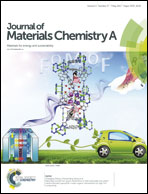Photoswitching storage of guest molecules in metal–organic framework for photoswitchable catalysis: exceptional product, ultrahigh photocontrol, and photomodulated size selectivity†
Abstract
MOF materials, as new catalysts, show high catalytic activity and size-, regio-, and stereo-selectivity. However, artificially controlling their catalytic process by convenient external stimulus such as light is still unexploited. Such photocontrol over an organic reaction may enable switchable catalytic activities and/or selectivities, consequently producing desired products from a pool of building blocks according to the order and type of stimuli applied. In this study, we present a novel MOF catalyst, which not only offers ultrahigh photocontrol with the on/off ratio as high as 407, but also displays disparate photomodulation in reaction kinetics towards various aldehyde substrates in light of their sizes, thus creating the first example of MOFs showing photoswitchable catalysis. The origin, as unveiled by photoswitching adsorption experiments and density functional theory calculations, is due to photoswitching storage of guest molecules in the metal–organic framework (MOF).



 Please wait while we load your content...
Please wait while we load your content...